Samsung 933HD Plus User Manual

SyncMaster 933HD Plus
LCD TV MONITOR
user manual
imagine the possibilities
Thank you for purchasing this Samsung product. To receive more complete service, please register your product at
www.samsung.com/register
Model |
|
Serial No. |
|

Important Warranty Information Regarding Television Format Viewing
NN See the warranty card for more information on warranty terms.
Wide screen format LCD Displays (16:9, the aspect ratio of the screen width to height) are primarily designed to view wide screen format full-motion video. The images displayed on them should primarily be in the wide screen 16:9 ratio format, or expanded to fill the screen if your model offers this feature and the images are constantly moving. Displaying stationary graphics and images
on screen, such as the dark sidebars on nonexpanded standard format television video and programming, should be limited to no more than 5% of the total television viewing per week.
Additionally, viewing other stationary images and text such as stock market reports, video game displays, station logos, web sites or computer graphics and patterns, should be limited as described above for all televisions. Displaying stationary images that exceed the above guidelines can cause uneven aging of LCD Displays that leave subtle, but permanent burned-in ghost images in the LCD picture. To avoid this, vary the programming and images, and primarily display full screen moving images, not stationary patterns or dark bars.
On LCD models that offer picture sizing features, use these controls to view different formats as a full screen picture.
Be careful in the selection and duration of television formats used for viewing. Uneven LCD aging as a result of format selection and use, as well as burned-in images, are not covered by your Samsung limited warranty.
Precautions When Displaying a Still Image
A still image may cause permanent damage to the TV screen
●● Do not display a still image on the LCD panel for more than 2 hours as it can cause screen image retention. This image retention is also known as “screen burn”. To avoid such image retention, reduce the degree of brightness and contrast of the screen when displaying a still image.
●● |
|
Watching the LCD TV in 4:3 format for a long period of time may leave traces |
|
|
of borders displayed on the left, right and center of the screen caused by the |
|
|
difference of light emission on the screen. |
|
|
Playing a DVD or a game console may cause a similar effect to the screen. |
|
|
Damages caused by the above effect are not covered by the Warranty. |
●● Displaying still images from Video games and PC for longer than a certain period of time may produce partial after-images.
To prevent this effect, reduce the ‘brightness’ and ‘contrast’ when displaying still images.
© 2009 Samsung Electronics Co., Ltd. All rights reserved.

Contents |
|
General Information |
|
■■Accessories.................................................. |
2 |
■■Viewing the Control Panel............................ |
2 |
■■Viewing the Connection Panel..................... |
3 |
■■Remote Control............................................ |
4 |
■■Installing Batteries in the Remote Control.... |
4 |
Connections |
|
■■Connecting VHF and UHF Antennas........... |
5 |
■■Connecting Cable TV................................... |
6 |
■■Connecting a DVD / Blu-Ray player / |
|
Satellite receiver (Set-Top Box) via HDMI.... |
7 |
■■Connecting a DVD / Blu-Ray player / |
|
Satellite receiver (Set-Top Box) via DVI....... |
8 |
■■Connecting a VCR....................................... |
8 |
■■Connecting a Camcorder............................. |
9 |
■■Connecting a PC........................................ |
10 |
Operation |
|
■■Turning the TV On and Off.......................... |
11 |
■■Plug & Play Feature.................................... |
11 |
CHANNEL CONTROL |
|
■■Configuring the Channel Menu.................. |
12 |
■■Managing Channels .................................. |
13 |
Picture Control |
|
■■Configuring the Picture Menu |
|
(TV / AV / HDMI )........................................ |
15 |
■■Using Your TV as a Computer (PC) |
|
Display....................................................... |
18 |
■■Setting up the TV with your PC.................. |
19 |
License
Sound Control |
|
■■Configuring the Sound Menu..................... |
20 |
Setup |
|
■■Configuring the Setup Menu...................... |
21 |
Input / Support |
|
■■Configuring the Input Menu........................ |
26 |
■■Configuring the Support Menu................... |
27 |
Anynet+ |
|
■■Connecting Anynet+ Devices..................... |
28 |
■■Setting Up Anynet+.................................... |
29 |
■■Switching between Anynet+ Devices......... |
30 |
■■Troubleshooting for Anynet+...................... |
31 |
Installing the Software |
|
■■Installing the Device Driver........................ |
32 |
■■Natural Color.............................................. |
32 |
■■MultiScreen................................................ |
33 |
Appendix |
|
■■TV Monitor Self-Diagnosis......................... |
34 |
■■Troubleshooting......................................... |
34 |
■■FAQ............................................................ |
36 |
■■Installing the Stand..................................... |
37 |
■■Disconnecting the Stand............................ |
37 |
■■Wall Mount Kit Specifications (VESA)........ |
37 |
■■Using the Anti-Theft Kensington Lock........ |
38 |
■■Securing the Installation Space.................. |
39 |
■■Specifications............................................. |
40 |
■■Power Saving Function.............................. |
40 |
Manufactured under license from Dolby Laboratories. Dolby and the double-D symbol are trademarks of Dolby Laboratories.
Symbol
N O T
Note |
One-Touch Button |
TOOLS Button |
English - 1
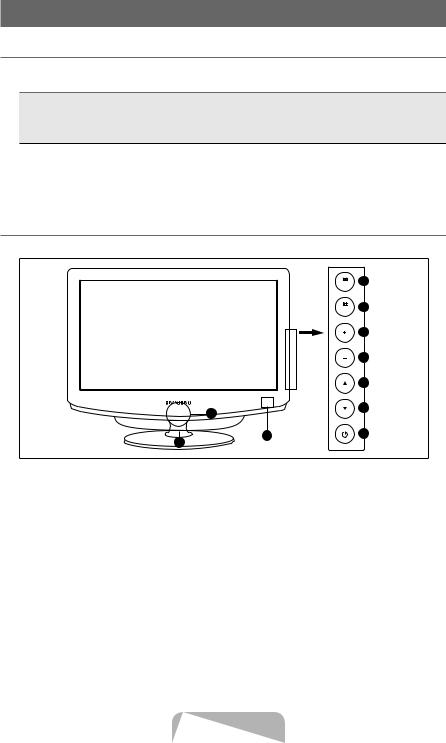
General Information
¦¦ Accessories
Please make sure the following items are included with your LCD TV. If any items are missing, contact your dealer.
Remote Control / Batteries (AAA x 2) (Not available in all locations) / Power Cord / Cleaning Cloth / User Manual (CD, Book) / Quick Setup Guide / Warranty Card (Not available in all locations) / Cable holder / Stand Base
NN The items color and shape may vary depending on the model.
NN Cleaning Cloth is only provided for highly polished black products as a product feature.
¦¦ Viewing the Control Panel
NN The product color an shape may vary depending on the model.
SOURCE
MENU
9
8
10
1
2
3
4
5
6
7
1SOURCEE: Toggles between all the available input sources. In the on-screen menu, use this E button as you use the button on the remote control.
2MENU  : Press to see an on-screen menu of your TV’s features.
: Press to see an on-screen menu of your TV’s features.
3,4 + / - : Moves from one menu item to another horizontally or adjusts selected menu values Adjusts the audio volume.
5,6 ,
, : Moves from one menu item to another vertically or adjusts selected menu values. In TV mode, selects TV channels.
: Moves from one menu item to another vertically or adjusts selected menu values. In TV mode, selects TV channels.
7P(POWER): Press to turn the TV on and off.
8REMOTE CONTROL SENSOR: Aim the remote control towards this spot on the TV.
9POWER INDICATOR: Blinks and turns off when the power is on and lights up in stand-by mode.
0SPEAKERS
English - 2
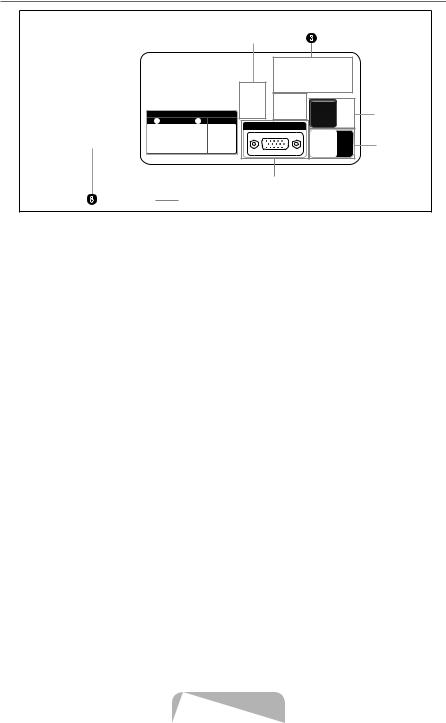
¦¦ |
Viewing the Connection Panel |
|
|
|
|
|
|
|
|
[TV Rear Panel] |
|
|
|
|
|
|
HDMI IN |
|
|
|
|
|
ANT IN |
|
POWER |
AV IN |
VIDEO |
|
|
|
R |
- AUDIO - |
L |
PC IN |
|
|
|
|
|
|
|
|
|
|
|
|
/ HDMI AUDIO |
|
|
|
|
|
PC IN |
NN The product color and shape may vary depending on the model.
1ANT IN
––Connects to an antenna or cable TV system.
2SERVICE
––Connector for service only.
3HDMI IN
––Connects to the HDMI jack of a device with an HDMI output.
NN No sound connection is needed for an HDMI to HDMI connection.
4AV IN
––Video and audio inputs for external devices, such as a camcorder or VCR.
5PC IN
––Connects to the video jacks on your PC.
6 

––Connect your headphones to the Headphone connection terminal.
7 HDMI / PC AUDIO IN
––Connect the HDMI / PC AUDIO IN terminal at the back of your product to your computer’s sound card.
8POWER INPUT
––Connects the supplied power cord.
9KENSINGTON LOCK
––The Kensington Lock (optional) is a device used to physically fix the system when used in a public place. If you want to use a locking device, contact the dealer where you purchased the TV.
NN The location of the Kensington Lock may be different depending on its model.
English - 3
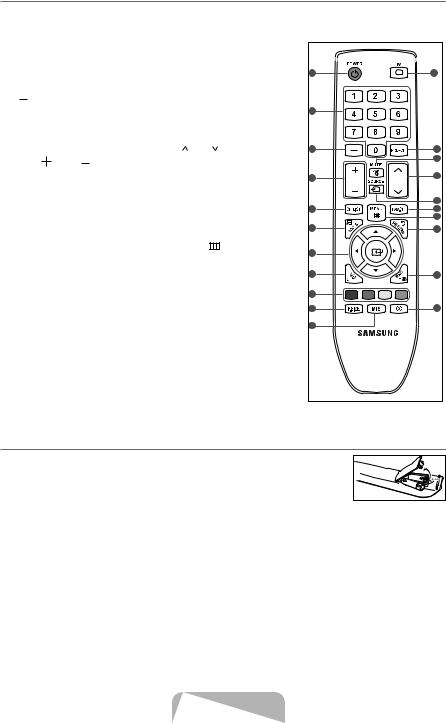
¦¦ |
Remote Control |
|
|
|
|
|
|
|
|
NN You can use the remote control up to a distance of about 23 feet from the TV. |
|
|
|||||
|
NN The performance of the remote control may be affected by bright light. |
|
|
|
||||
1 |
POWER:Turns the TV on and |
@ TV: Selects the TV mode |
|
|
|
|
||
|
off. |
|
directly. |
|
|
|
|
|
2 |
NUMERIC BUTTONS: Press to |
# |
PRE-CH: This button |
1 |
|
|
12 |
|
|
change the channel. |
|
is used to return to the |
|
|
|
|
|
3 |
: Press to select additional |
|
previous channel viewed. |
|
|
|
|
|
|
channels (digital) being broadcast |
$ MUTE M: Press to |
2 |
|
|
|
||
|
by the same station. For example, |
|
temporarily cut off the |
|
|
|
|
|
|
to select channel ‘54-3’, press |
|
sound. |
|
|
|
|
|
|
‘54’, then press ‘-’ and ‘3’. |
% |
CH |
: Press to change |
3 |
|
|
13 |
4 |
VOL / VOL : Press to |
|
channels. |
|
|
|
|
14 |
|
|
|
|
|
|
|||
|
increase or decrease the |
^ |
SOURCE: Press to display |
4 |
VOL |
CH |
15 |
|
|
volume. |
|
||||||
|
|
and select the available |
|
|
|
|
||
5 |
CH LIST: Used to display |
|
video sources. |
5 |
|
|
16 |
|
|
Channel Lists on the screen. |
& FAV.CH: Press to switch to |
|
|
17 |
|||
|
|
|
|
18 |
||||
6 |
TOOLS: Use to quickly select |
|
your favorite channels. |
6 |
|
|
19 |
|
|
frequently used functions. |
* |
MENU |
: Displays the |
|
|
|
|
7 |
UP▲/DOWN▼/LEFT◄/ |
|
main on-screen menu. |
7 |
|
|
|
|
|
|
|
|
|
||||
|
RIGHT►/E: Use to select on- |
( RETURN: Returns to the |
8 |
|
|
20 |
||
|
screen menu items and change |
|
previous menu. |
|
|
|
|
|
|
menu values. |
|
9 |
|
|
|
||
|
) |
EXIT:Press to exit the |
|
|
|
|||
8 |
INFO: Press to display |
10 |
|
|
21 |
|||
|
menu. |
|
|
|
||||
|
|
|
|
|
|
|
||
|
information on the TV screen. |
a |
CC:Controls the caption |
11 |
|
|
|
|
9 |
COLOR BUTTONS: Use these |
|
|
|
|
|||
|
decoder. |
|
|
|
|
|
||
|
buttons in the Channel list, etc. |
|
|
|
|
|
|
|
0 P.SIZE:Picture size selection.
!MTS:Press to choose stereo, mono or Separate Audio Program (SAP broadcast).
¦¦ Installing Batteries in the Remote Control
1. Lift the cover at the back of the remote control upward as shown in the figure.
2. Install two AAA size batteries.
NN Make sure to match the “+” and “–” ends of the batteries with the diagram inside the compartment.
3.Replace the cover.
NN Remove the batteries and store them in a cool, dry place if you won’t be using the remote control for a long time. (Assuming typical TV usage, the batteries should last for about one year.)
NN If the remote control doesn’t work, check the following:
●● Is the TV power on?
●● Are the plus and minus ends of the batteries reversed? ●● Are the batteries drained?
●● Is there a power outage or is the power cord unplugged?
●● Is there a special fluorescent light or neon sign nearby?
English - 4
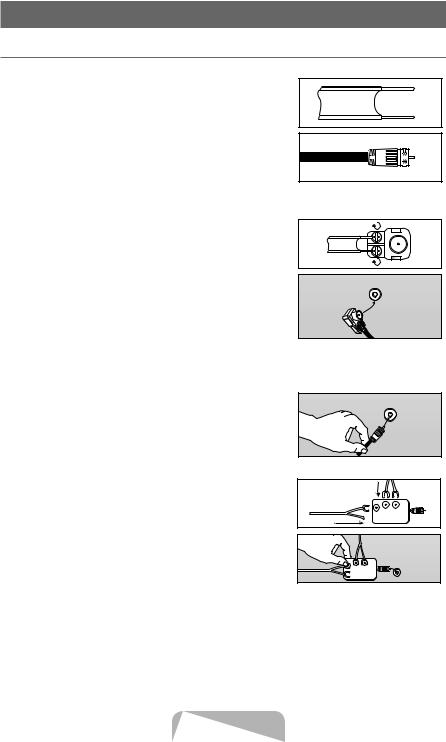
Connections
¦¦ Connecting VHF and UHF Antennas
If your antenna has a set of leads that look like the diagram to the right, see ‘Antennas with 300 Ω
Flat Twin Leads’ below.
If your antenna has one lead that looks like the diagram to the right, see ‘Antennas with 75 Ω Round Leads’.
If you have two antennas, see ‘Separate VHF and UHF Antennas’.
Antennas with 300 Ω Flat Twin Leads
If you are using an off-air antenna (such as a roof antenna or
‘rabbit ears’) that has 300Ω twin flat leads, follow the directions below.
1.Place the wires from the twin leads under the screws on a 300-
75 Ω adapter (not supplied). Use a screwdriver to tighten the screws.
2.Plug the adaptor into the ANT IN terminal on the back of the TV.
Antennas with 75 Ω Round Leads
Plug the antenna lead into the ANT IN terminal on the back of the TV.
Separate VHF and UHF Antennas
If you have two separate antennas for your TV (one VHF and one UHF), you must combine the two antenna signals before connecting the antennas to the TV. This procedure requires an optional combiner-adaptor (available at most electronics shops).
1.Connect both antenna leads to the combiner.
2.Plug the combiner into the ANT IN terminal on the bottom of the rear panel.
ANT IN
ANT IN
UHF

 VHF
VHF
ANT IN
UHF
 VHF
VHF
English - 5
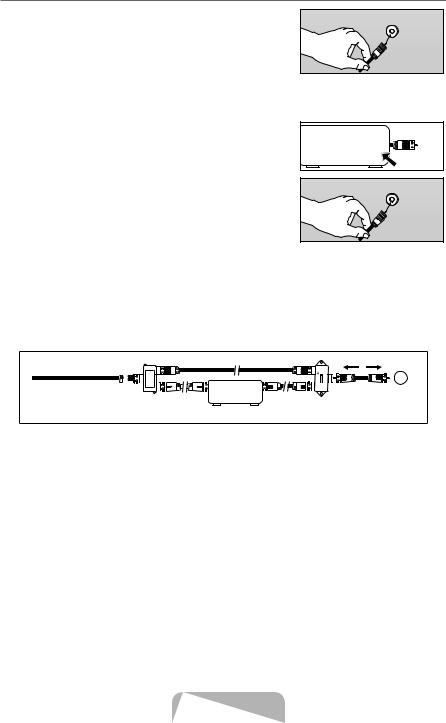
¦¦ Connecting Cable TV
To connect to a cable TV system, follow the instructions below.
Cable without a Cable Box
Plug the incoming cable into the ANT IN terminal on the back of the TV.
NN Because this TV is cable-ready, you do not need a cable box to view unscrambled cable channels.
ANT IN
Connecting to a Cable Box that Descrambles All Channels
1.Find the cable that is connected to the ANT OUT terminal on your cable box.
NN This terminal might be labeled ‘ANT OUT’, ‘VHF OUT’ or simply, ‘OUT’.
2.Connect the other end of this cable to the ANT IN terminal on the back of the TV.
ANT IN |
ANT OUT |
ANT IN
Connecting to a Cable Box that Descrambles Some Channels
If your cable box descrambles only some channels (such as premium channels), follow the instructions below. You will need a two-way splitter, an RF (A/B) switch and four lengths of RF cable. (These items are available at most electronics stores.)
ANT IN
Incoming cable 










































 TV Rear
TV Rear
Splitter |
RF (A/B) Switch |
|
Cable Box
1.Find and disconnect the cable that is connected to the ANT IN terminal on your cable box. NN This terminal might be labeled ‘ANT IN’, ‘VHF IN’ or simply, ‘IN’.
2.Connect this cable to a two-way splitter.
3.Connect an RF cable between the OUTPUT terminal on the splitter and the IN terminal on the cable box.
4.Connect an RF cable between the ANT OUT terminal on the cable box and the B–IN terminal on the RF(A/B) switch.
5.Connect another cable between the other OUT terminal on the splitter and the A–IN terminal on the RF (A/B) switch.
6.Connect the last RF cable between the OUT terminal on the RF (A/B) switch and the ANT IN terminal on the rear of the TV.
After you have made this connection, set the A/B switch to the ‘A’ position for normal viewing. Set the A/B switch to the ‘B’ position to view scrambled channels. (When you set the A/B switch to ‘B’, you will need to tune your TV to the cable box’s output channel, which is usually channel 3 or 4.)
English - 6
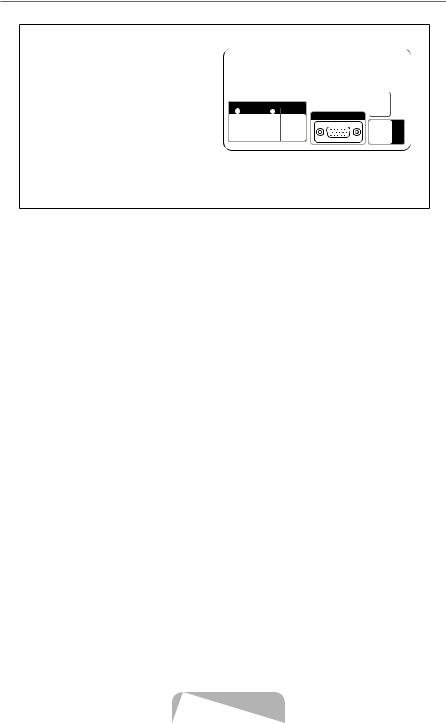
¦¦ Connecting a DVD / Blu-Ray player / Satellite receiver (Set-Top Box) via HDMI
This connection can only be made if there is an HDMI Output connector on the external device.
DVD / Blu-Ray player / Satellite receiver |
TV Rear Panel |
|
(Set-Top Box) Rear Panel |
|
|
|
ANT IN |
|
|
AV IN |
|
R |
- AUDIO - L VIDEO |
PC IN |
|
|
C P/ HDMI
N IO UDA I
1 HDMI Cable (Not supplied)
NN What is HDMI?
●● HDMI(High-Definition Multimedia Interface), is an interface that enables the transmission of digital audio and video signals using a single cable.
●● The difference between HDMI and DVI is that the HDMI device is smaller in size and has the HDCP (High Bandwidth Digital Copy Protection) coding feature installed.
NN Each DVD / Blu-Ray player / Satellite receiver (Set-Top Box) has a different back panel configuration.
NN The TV may not output sound and pictures may be displayed with abnormal color when DVD / Blu-Ray player / Satellite receiver (Set-Top Box) supporting HDMI versions older than 1.3 are connected. When connecting an older HDMI cable and there is no sound, connect the HDMI cable to the HDMI IN jack and the audio cables to the HDMI / PC AUDIO IN jacks on the back of the TV. If this happens, contact the company that provided the DVD / Blu-Ray player / Satellite receiver (Set-Top Box) to confirm the HDMI version, then request an upgrade.
NN HDMI cables that are not 1.3 may cause annoying flicker or no screen display.
English - 7

¦¦ Connecting a DVD / Blu-Ray player / Satellite receiver (Set-Top Box) via DVI
This connection can only be made if there is a DVI Output connector on the external device.
TV Rear Panel
DVD / Blu-Ray player / |
|
|
|
|
|
|
|
|
|
|
|
||||||||||
|
Satellite receiver |
|
|
|
|
|
|
|
|
|
|
|
|||||||||
|
|
(Set-Top Box) |
|
|
|
|
|
|
|
|
|
|
|
||||||||
|
|
|
|
|
|
|
|
|
|
|
|
|
|
|
ANT IN |
|
|
|
|
|
|
|
|
|
|
|
|
|
|
|
|
|
|
|
|
|
|
|
|
|
|
|
|
|
|
|
|
|
|
|
|
|
AV IN |
|
|
|
|
|
|
|
|||||
|
|
|
|
|
|
|
|
|
|
|
|||||||||||
|
|
|
|
|
|
|
R |
|
|
L |
|
|
|
|
|
|
|
|
|
||
|
|
|
|
- AUDIO - |
|
VIDEO |
|
|
|
|
|
|
|
||||||||
|
|
|
|
|
|
|
|
|
|
|
|
|
|
|
|
|
PC IN |
|
|
|
|
|
|
|
|
|
|
|
|
|
|
|
|
|
|
|
|
|
|
|
|
|
|
|
|
|
|
|
|
|
|
|
|
|
|
|
|
|
|
|
|
|
|
|
|
|
|
|
|
|
|
|
|
|
|
|
|
|
|
|
|
|
|
|
|
|
|
|
|
|
|
|
|
|
|
|
|
|
|
|
|
|
|
|
|
|
|
|
|
|
|
|
|
|
|
|
|
|
|
|
|
|
|
|
|
|
|
|
|
|
|
 2 RCA to stereo Cable (Not supplied)
2 RCA to stereo Cable (Not supplied) 

 1 DVI to HDMI Cable (Not supplied)
1 DVI to HDMI Cable (Not supplied)
NN Each DVD / Blu-Ray player / Satellite receiver (Set-Top Box) has a different back panel configuration.
NN When connecting a DVD / Blu-Ray player / Satellite receiver (Set-Top Box), match the color of the connection terminal to the cable.
¦¦ Connecting a VCR
TV Rear Panel
VCR Rear Panel

 2Audio Cable (Not
2Audio Cable (Not 
supplied)
1 Video Cable (Not supplied)
NN If you have a ‘mono’ (non-stereo) VCR, use a Y-connector (not supplied) to connect to the right and left audio input jacks of the TV. Alternatively, connect the cable to the ‘R’ jack. If your VCR is stereo, you must connect two cables.
NN Each VCR has a different back panel configuration.
NN When connecting a VCR, match the color of the connection terminal to the cable.
English - 8
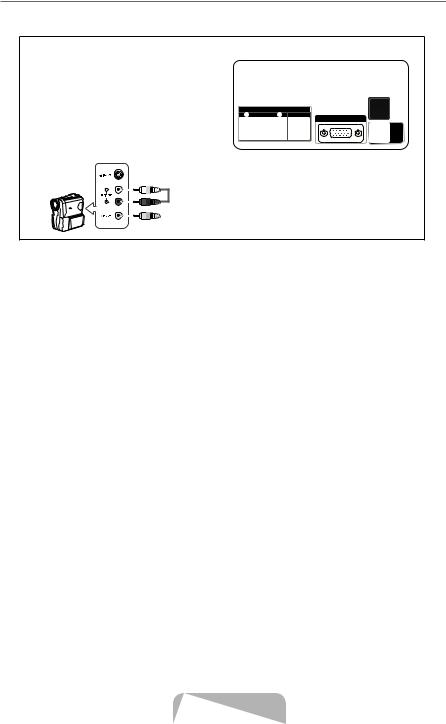
¦¦ Connecting a Camcorder
Using a Video Cable
TV Rear Panel
Camcorder |
2 Audio Cable |
|
|
|
(Not supplied) |
|
1 Video Cable (Not supplied) |
NN Each Camcorder has a different back panel configuration.
NN When connecting a Camcorder, match the color of the connection terminal to the cable.
Using an HDMI Cable
TV Rear Panel
HD Camcorder
1 HDMI Cable (Not supplied)
1.Connect an HDMI Cable between the HDMI IN jack on the TV and the HDMI OUT jack on the camcorder.
English - 9
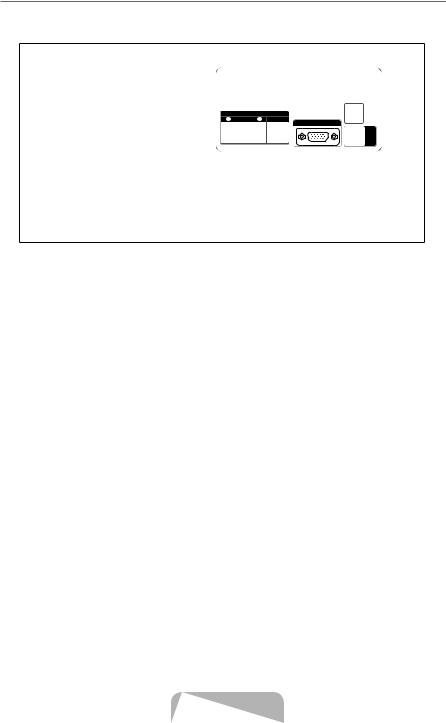
¦¦ Connecting a PC
Using the D-Sub Cable
TV Rear Panel
HDMI IN
PC |
|
|
ANT IN |
|
|
|
|
|
|
AV IN |
VIDEO |
R |
- AUDIO |
- L |
1 D-Sub Cable
2 Stereo Cable (Not supplied)
NN When connecting a PC, match the color of the connection terminal to the cable.
Using the HDMI Cable
TV Rear Panel
PC
|
|
|
|
|
|
|
|
|
|
|
|
|
|
|
|
|
ANT IN |
||
|
|
|
|
|
|
|
|
|
|
|
|
AV IN |
|
|
|
|
|
||
R |
|
L |
|
|
|
|
|
||
- AUDIO - |
VIDEO |
|
|
|
|||||
|
|
|
|
|
|
|
|
|
PC IN |
1 HDMI Cable (Not supplied)
2 Stereo Cable (Not supplied)
NN Each PC has a different back panel configuration.
English - 10

Operation
¦¦ Turning the TV On and Off
Press the POWER Pbutton on the remote control. You can also use the Pbutton on the TV.
¦¦ Plug & Play Feature
When the TV is initially powered on, basic settings proceed automatically and subsequently.
1.Press the POWER Pbutton on the remote control. NN You can also use the Pbutton on the TV.
Plug & Play
Select Language of the OSD.
Language |
: English |
r |
EEnter
2.Press the Ebutton, then “Select Language of the OSD.” menu is automatically displayed.
3.Press the ▲ or ▼ button to select language, then press the Ebutton. The message “Select ‘Home Use’ when installing this TV in your home.” is displayed.
4.Press the ◄ or ► button to select “Store Demo” or “Home Use”, then press the Ebutton. The message “Select the Antenna source to memorize.” is displayed.
NN We recommend setting the TV to “Home Use” mode for the best picture in your home environment.
NN “Store Demo” mode is only intended for use in retail environments. If the unit is accidentally set to “Store Demo” mode and you want to return to “Home Use” (Standard): Press the volume button on the TV. When the volume OSD is displayed, press and hold the MENU button on the TV for 5 seconds.
5.Press the ▲ or ▼ button to memorize the channels of the selected connection. Press the Ebutton to select “Start”.
NN Air: “Air” antenna signal. / Cable: “Cable” antenna signal. / Auto: “Air” and “Cable” antenna signals.
NN In Cable mode, you can select the correct signal source among STD, HRC, and IRC by pressing the ▲, ▼, ◄ or ► button, then press the Ebutton. If you have Digital cable, select the cable system signal source for both Analog and Digital. Contact your local cable company to identify the type of cable system that exists in your particular area.
6.Press the Ebutton to select “Start”. The TV will begin memorizing all of the available channels.
NN To stop the search before it has finished, press the Ebutton with “Stop” selected.
NN After all the available channels are stored, it starts to remove scrambled channels. The Auto program menu then reappears. Press the Ebutton when channel memorization is complete. The message “Set the Clock Mode.” is displayed.
7.Press the Ebutton.
Press the ▲ or ▼ button to select “Auto”, then Press the Ebutton. The message “Set to daylight saving time.” is displayed. If you select “Manual”, “Set current date and time” is displayed.
8.Press the ▲ or ▼ button to select “Off”, “On” or “Auto”, then press the button.
9.Press the ▲ or ▼ button to highlight the time zone for your local area. Press the Ebutton. If you have received a digital signal, the time will be set automatically.
10.The connection method to provide the best quality HD is offered.After confirming the method, press the Ebutton.
11.The message “Enjoy your TV.” is displayed. When you have finished, press the Ebutton.
English - 11
